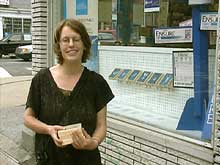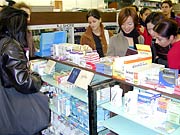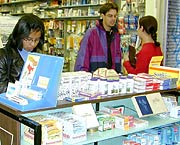


Diplômée en arts visuels de l'Université Concordia, Loren Williams vit et travaille à Montréal. Ses plus récents travaux in situ comprennent The Bird Room, des cyanotypes réalisés à partir d'oiseaux empaillés présentés au Musée Redpath de Montréal (2000), et Flotsam et Jetsam, installé au Musée maritime de l'Atlantique à Halifax (1998). From the Garden of Poisonous Plants, une série de photographies sur les plantes vénéneuses produite en 1996, traite du poison comme arme domestique subversive et de son utilisation par les femmes à travers l'histoire. Cabinet de curiosité (1995) est construit autour d'une variété de résidus naturels et d'objets abandonnés recueillis par l'artiste.
Pharmacie N.J. Shore
85, rue Villeneuve Ouest
Le pouvoir de soigner est un don précieux et les moyens
utilisés à travers l’Histoire sont riches d’anecdotes oscillant entre la médecine et la sorcellerie. Dans des coffrets disséminés parmi les produits pharmaceutiques, Pharmacy répertorie minutieusement les ingrédients — des plantes et insectes aux diverses propriétés, anciennement utilisés dans les recettes les plus étranges. Le passé et le présent se confondent sur les étagères, incitant notre imagination fertile à recréer une officine où l’on pourrait concocter les potions les plus miraculeuses.


Pharmacy
The power to heal is a precious gift, and the history of healing methods is replete with anecdotes that oscillate between medicine and witchcraft. In boxes disseminated among the pharmaceutical products, Pharmacy presents a minute repertory of ingredients; plants and insects with diverse properties, which in the past went into some very strange recipes. The past and present coalesce on the shelves and stimulate our fertile imaginations to recreate a dispensary where one can concoct miraculous potions of one’s own.
Excerpt from
Villeneuve revisited
by Sylvette Babin
Translation by
Bernard Schutze
STATEMENT
When king Charles II of England fell ill on Feb. 2nd, 1685, a team of no fewer than 14 royal physicians endeavoured to cure him. To remove the 'ill humours', he was bled, purged, and bled again. His head was smeared with blistering camphor and mustard plasters of Spanish fly, and powder from the poisonous rhizome of the white hellebore lily was blown up his nostrils. The next morning, Tuesday, he was again bled and given a sweet julep of black cherry, peony, lavender, crushed pearls and white sugar. On Wednesday, showing no signs of improvement, he was bled and given 'a draft made from the pulverised skull of an innocent man who met a violent death'. On Thursday, exhausted, dehydrated and in great pain, the king was re-bled, re-purged, given an enema, and given Jesuit's bark, a preparation heavily laced with quinine. By Friday he was worse. Not to be defeated, the physicians bled Charles almost bloodless and prescribed an antidote which contained 'extracts of all the animals and herbs in the kingdom'. The king grew breathless, again he was bled. Early Saturday morning his speech faltered and failed. A couple hours later he was mercifully comatose. At noon he finally died, a testament to the stamina of the human body.
Condensed from:
Panati's extraordinary endings of practically everything and everybody.
Charles Panati.
The Shore Pharmacy on rue Villeneuve, has been around for almost 50 years, the building has been used as a pharmacy for over 70. A collection of mortars & pestles sits high above the prescription counter, and drugstore products from various eras are displayed on shelves below.
It's a wonderful, quirky, neighbourly place, situated as much in the past as it is in the present. Using the Shore Pharmacy as an exhibition site for my work, I proposed an installation of small cyanotype-photos that reflected early medical history. Like the 17th c. antidote containing 'extracts from the animals and herbs of the kingdom', the cyanotype images portrayed various plants, animals, and insects. Forming a collection, the cyanotype-photos were integrated into the displays of medical products in the pharmacy. In the same way that the past co-habits with the present in the Shore Pharmacy, the cyanotype photo installation mingled remedies from medical history with the medical products of today.